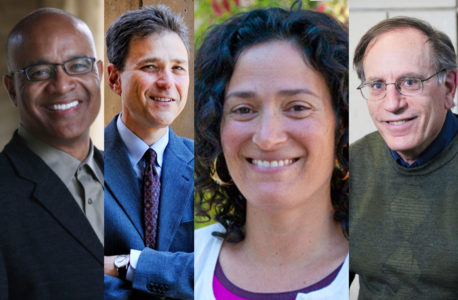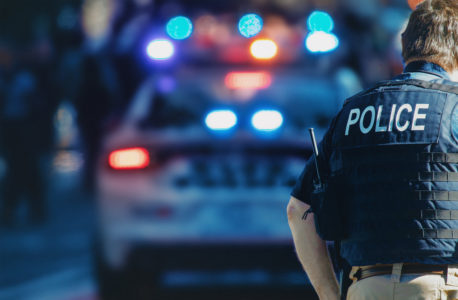Selective De-Policing: Stanford Law Team Proposes New Routes to Public Safety in Racially Diverse Communities
Report on non-police approaches to mental health and homeless crises, school discipline, and traffic violations demonstrates public safety benefits, especially for vulnerable communities
The death of George Floyd on May 25 sparked protests in cities across the United States, often including calls to “de-fund the police.” But many public officials and reformers oppose reductions in the number of officers or cuts in police funding.
Instead of viewing police funding as a monolith, a new report by Stanford Law School faculty and students proposes disaggregating the many jobs performed by police departments and spinning off particular functions to other agencies. The report shows that questions about policing, and the expansion of the use of police officers into sensitive areas such as schools and mental health interventions, have been with us for decades—and that promising alternatives have been piloted in a variety of places around the country.

Faculty and students in the policy practicum Selective De-Policing: Operationalizing Concrete Reforms, aided by a unique partnership with the African American Mayors Association (AAMA), detail some of the most successful attempts at “selective de-policing” in the country and offer recommendations for alternatives to armed police interventions that have shown promising results, and often savings to communities—in both city budgets and public safety. The practicum was co-taught by Ralph Richard Banks, Jackson Eli Reynolds Professor of Law and faculty director of the Stanford Center for Racial Justice (SCRJ); Robert Weissberg, Edwin E. Huddleson, Jr. Professor of Law, associate dean for curriculum, and faculty co-director of the Stanford Criminal Justice Center (SCJC); David A. Sklansky, Stanley Morrison Professor of Law and SCJC faculty co-director; and Debbie Mukamal, SCJC executive director.
Research began in September last year and finished with the report Safety Beyond Policing: Promoting Care Over Criminalization, published April 2021. The report was presented to members of the AAMA in April and will be shared with local governments and law enforcement agencies in the state in the coming months.
“The idea behind the policy lab was to put aside, for the moment, the question of the best overall level of policing, and instead to ask whether there are particular responsibilities that police departments have taken on over time but that might be better handled by other agencies,” says Sklansky, a former federal prosecutor and criminal law expert.
“The students’ work shows that we have asked police to do too much. Paradoxically, the way to improve the work that police do is to ask them to do less—and to engage with experts who are better able to address key issues,” says Banks. “These are not new issues but ones that have been with us for a long time. They have assumed heightened salience in the last year and the work we’ve done in this policy lab is one way to offer ideas to address long-standing issues that we need to address.”
“The notion that civilian leaders, that is to say non-police including the mayors, want to drastically reduce the presence of police in their local government functions is simply not true. It’s a matter of finding ways to surface the report’s findings that show that certain changes will not only not improve the city’s response to vulnerable communities, it will actually enhance public safety by freeing up police officers to do certain things they really need to do,” says Weisberg. “These changes can also create better trust of government and of the police among residents.”

The twelve students enrolled in the policy lab examined alternatives to traditional police enforcement in three key areas that have been flashpoints in recent controversies between police and racially diverse localities, sometimes with deadly consequences: responses to people in mental health crisis, interactions with unhoused populations, traffic enforcement, and school safety.
Through a partnership with the AAMA, the policy practicum team gained valuable access to public officials in cities that ranged in size from Holly Hill, South Carolina with just over 1,000 residents to Houston, Texas with 2.3 million. Students spoke with officials in cities across the country who have implemented reforms designed to replace police with civilians trained in key areas such as social work and mental health. In addition to interviews with AAMA mayors and staff including police officers, they conducted 22 interviews with academics, nonprofit leaders, politicians, agency staff, civil service workers, and a local judge.
Key findings and concrete steps recommended in the report have been found to save money and improve public welfare by moving particular jobs to providers other than police officers.
Perhaps surprising, given the polarized controversy over calls to “de-fund the police,” is the number of communities exploring solutions that cannot be pigeonholed simply as “more police” or “less police,” but instead address what the police are asked to do.
“Innovative alternatives to traditional policing are happening right now and those cities that are trying alternatives are experiencing tremendous cost savings. These reforms are feasible,” says Michelle Portillo, JD ’21, who researched mental health and unhoused population contact with police and alternatives using mental health professionals as first responders.
The report points out that over the past six years mental health emergencies constitute 10 percent of all 911 calls but a quarter of all police-involved shooting deaths. “This makes sense because police are often ill-equipped to provide the help needed by someone in a mental health crisis, and first response by police risks escalation into violence,” Portillo says, noting that the team believes that by replacing police as the default response with first-responder professional teams will lead to fewer interactions with the police and therefore likely will result in fewer police involved shootings.

Portillo and her colleagues also discovered that many cities spend millions of dollars on ambulance interventions for unhoused populations and those with mental illness. One program they researched is Crisis Assistance Helping Out on the Streets, or CAHOOTS, a mental health first responder team program that started in Eugene, Oregon in 1989 in which unarmed mental health counselors working in teams respond to non-violent mental health crises, allowing the police force to focus on public safety issues. The city estimates that CAHOOTS saves it $8.5 million annually in public safety spending and $14 million for ambulance and emergency room treatment. The program has been replicated across the country.
“Some police are excited about this and would like to redirect their work to those who are most dangerous. They have limited resources and expertise in this area,” says Portillo.
Race, A Common Thread
The three areas of study—police interaction in mental health crisis and homeless populations response, traffic enforcement, and school discipline—share a common thread of racial disparity. “Study after study shows that Black Americans in particular are, in relation to whites, stopped or arrested disproportionately in relation to population and demonstrable crime rate, more likely to searched, and more likely to be subjected to police force including deadly force across a variety of jurisdictions,” the authors write in the report.
Traffic enforcement, with broad legal authority given to police to stop drivers for even minor infractions, has been shown to be a pressure point for police escalation. Statistics included in the report for traffic enforcement—one noting that almost half of stops made by police were of Black drivers—shine a light on the challenges of racial profiling, or what has become known as “driving while Black.”
“The law is such that it’s very hard not to do something while driving that might be cause for a cop to legally stop you,” says Weisberg. “And this can get leveraged into something else.”
The report points to a program recently approved in Berkeley, California aimed at limiting routine traffic stops by its police department and reassigning traffic enforcement to unarmed civil employees. By limiting opportunities for police stops the hope is that the city will limit escalations too.
The report also points to racial disparities in school safety, with armed police disproportionately present on majority Black campuses—and Black students three times more likely than their peers to attend schools with more security staff than mental health professionals. Today, 45 percent of American public schools hire police at a cost of more than half a billion dollars each year. Over a five-year period, police arrested more than 30,000 children ages nine and younger. Among the report’s recommendations is the replacement of police officers with social workers, civilian safety officers who are trained to intervene in and deescalate conflicts among students. Schenectady City School District in New York implemented such a program and has seen a 40 percent reduction in public altercations at their schools.
Concrete Proposals for Change
The report offers concrete examples and proposals—such as adopting permissive ordinances for homelessness, sending crisis counselors instead of police to mental health emergencies, and implementing restorative justice practices in schools—which can help local jurisdictions address public health concerns efficiently and free up valuable law enforcement resources. The policy practicum team plans to present its findings to California law makers in the coming months. And while optimistic, they are clear-eyed.
“The biggest obstacle is institutional inertia and a long-standing pattern of just throwing problems at the police when we don’t have anyone else to deal with them,” says Sklansky.
“How we address mental health issues and our homeless communities raise complicated public policy issues that only become the work of law enforcement because we don’t have other infrastructures in place to address them,” adds Banks. “The report will hopefully prompt people to think of non-law enforcement alternatives to address some of these challenges.”
